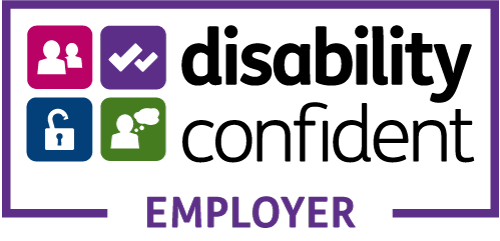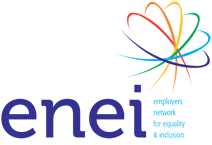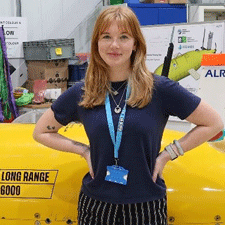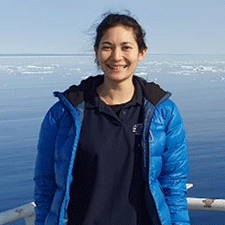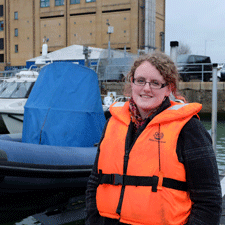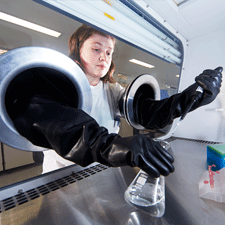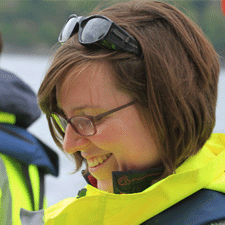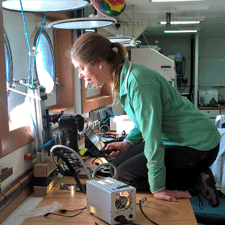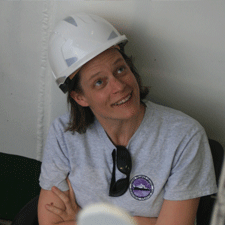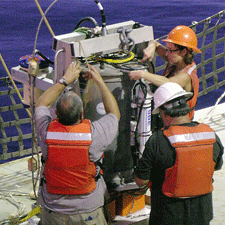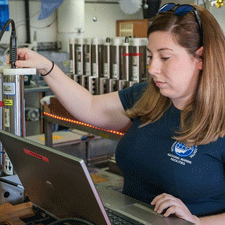Tina Thomas
I am a Moorings Technician, part of a team that prepares the hardware and scientific instruments for our moorings from a calculated mooring design. A portion of my job requires that I go to sea to deploy the moorings we prepare, using the ship’s cranes, frames, and winches. After the mooring has been in the sea for as little as a day or for as long as 4 years, depending on the project, we go back to recover it. Once recovered, we breakdown the mooring, upload the data, then clean and recycle what we can to be used in a future deployment. Moorings are an incredible reference, specifically as a time series, that enable scientists to see how the ocean changes in a precise location over time.
Career path
After graduating from university with a degree in engineering, I worked for 14 years as a shipboard marine technician on many research vessels in the US and abroad, before moving to the UK in 2022 to work at NOC. My role as a shipboard technician varied depending on the size of the ship. As an active crew member, I was able to accrue experience in many areas of responsibility including, but not limited to; scientific instrumentation, computers and networks, electronics, cranes and winches, deploying and recovering instruments large and small, assisting with the engines and generators, and driving the vessel.
What’s your career highlight to date?
I had the opportunity to outfit the scientific suite of instruments as well as the accompanying electronics for a newly built research vessel in my hometown.
What’s the best thing about working at NOC?
Working at NOC and sailing on the research ships allows me to travel the world and see remote places.
What one piece of career advice would you give to women or girls thinking about a role in science or engineering?
Be open to learning about new things. You never know what might spark an interest and lead you down a fun path.
Chloe Baker
I am a Frontend Software Engineer, a member of the team responsible for developing the Command and Control (C2) system that simplifies the operation of the Marine Autonomous Systems (MAS) fleet. My primary responsibilities include contributing to the development, testing, and debugging of the C2 system. Additionally, I play an active role in designing new features and components.
Qualifications
I have a Level 6 in Digital and Technology Solutions as a Software Engineer and a BSc Hons in Digital and Technology Solutions.
Career Path
After completing my A-levels, I began a Degree Apprenticeship with AirSensa, where I worked part-time as a Software Developer. However, halfway through, I switched to Huler, where I focused on developing their employee experience platform. Once I completed my Degree Apprenticeship, I started working at NOC as a Frontend Software Engineer, within in the C2 team.
Support for equality and diversity
Since a young age, I have developed a strong passion for technology, which made me one of the few girls in most of my classes. Though it was daunting at first, I enjoyed every bit of it and always felt included. My colleagues, classmates, and lecturers have always been a great source of inspiration for me. I highly encourage anyone aspiring for a career in STEM to pursue their dream, as it was the best decision I ever made.
Best thing about working at NOC
I find it hard to choose just one thing that I love about working at NOC. Firstly, it’s not like working at any other company. Not many people can say that they work with autonomous underwater vehicles! Besides the fact that the work itself is thrilling, the culture and the people at NOC are fantastic. Everyone is so kind and friendly. Also, I find the work we do very meaningful, and it inspires me to know that in some way, I am contributing to research that can benefit the world and everyone in it.
Emmy McGarry
I am a Ship Scientific System Technician, we look after (calibrate, upgrade, collect data from, troubleshoot) the fitted scientific sensors onboard the two ships, so that’s all the meteorological sensors like light and air pressure, the underway sensors such as the salinity and surface water temperature and the ADCPs and various echosounders which measure things like current and depth. Whilst onboard we also make sure that the data collected is secure and accessible to the scientists and enable them and the mariners to stay in contact with shore by maintaining an internet connection.
Qualifications
BA Biological Sciences, PGCE Secondary Science, MSc Oceanography
Career Pathway
I’ve had a few careers finding the role that fits. I’m a fully qualified Secondary Science teacher, sailed around America, researched HIV vaccines then became a project manager for clinical trials but still wasn’t settled. I then realised that I could combine my love of the ocean and science, went back to university to do a MSc in Oceanography in Southampton which led to working as a research technician on the ship and finally to my current role as an engineering technician, where I’ve been for three years now and finally feel at home.
Favourite thing about my job
I love the variety of my job, there’s always something different to do or learn about. Whilst on the research ships it’s brilliant slotting back into the close-knit community that the ship becomes and I’m always amazed that I get paid to be out in the ocean, having a tea break looking out on a pod of dolphins or watching an iceberg float past the window during dinner. I also enjoy the shore work, usually our group goes to sea alone so it’s good to come back to the office to share experiences and ideas with my colleagues or discuss issues encountered at sea. Then there’s the planning work for future expeditions or upgrades to the ship equipment which tends to keep me busy for the rest of the time.
What’s the best thing about working at NOC?
I chose to do my MSc Oceanography at Southampton University because of its close links with NOC as it was always my plan to get on the research vessels which NOC looks after. So my favourite thing about NOC is still its links with the ships but it’s also really important to me to work in an organisation that I feel is playing an important role in the research of the marine environments and therefore making a generally positive impact.
What one piece of career advice would you give to women or girls thinking about a role in science or engineering?
Even if you don’t think you’re qualified/experienced enough to apply for a job it’s always worth applying if it’s a role you think you’d enjoy. You miss 100% of the shots you don’t take.
Dr Allison Schaap
Allison is Associate Head Ocean Technology and Engineering and Research Engineer working on microfluidic sensors.
I am part of a team that develops sensors to measure ocean chemistry. I do a mix of interdisciplinary engineering and scientific work. On the theoretical side, this includes working with fluid mechanics, CAD software, modelling, writing scripts, performing data analysis, and report writing. In the lab, I build, test, fix, and characterise instruments and run experiments on new designs or methods. I’ve also done some field work using the sensors out in exciting places.
Qualifications
PhD in Mechanical Engineering (from the Eindhoven University of Technology, the Netherlands); Masters in Mech. Eng. and Bachelors in Engineering Physics (both from the University of British Columbia, Canada)
Career Pathway
This is my first “real” job after finishing my PhD. However, throughout my undergraduate degree I worked part-time in a lab which specialised in analytical chemistry and instrumentation for environmental applications, which is what got me interested in doing research and in this field in general.
Number of days at sea
I haven’t been to sea properly (other than small day trips) but I’ve done some field work since starting at the NOC two years ago: I’ve spent a total of over a month in three different countries deploying the sensors and training other users on them. This has ranged from well-equipped labs to lower-resource environments.
Favourite thing about my work
I really enjoy the interdisciplinary and mixed nature of my work and the group I’m in. It’s great to be able to see technology go from idea, to testing, to reality, to deployment, and that complete path isn’t something you always have in other research environments. It’s also fantastic to be able to work together closely with such a broad range of experts: you can learn some chemistry from the chemists, some electrical engineering from the electrical engineers, some oceanography from the oceanographers, and pull it all together for your own work.
Best technology you’ve developed
Of course the best technology I’ve used is the sensors we develop ourselves! Really though, it’s great to be able to see microfluidic and lab-on-a-chip technology, which is often used in labs but not often brought to commercial fruition, come into its own in environmental fieldwork. In this application it matters dramatically if you can cut down the consumption of power or reagents/chemicals on your sensor by miniaturising it. It means you get more data for a longer time, and on top of that it’s a lot easier to carry around when you’re using it!
Dr Annika Simpson
Annika is the Manager of our Molecular and Microbiology Facility.
I manage the NOC’s molecular and microbiology labs. Though a microbiologist by training, I am here to make sure the scientists and engineers in the group have everything they need for their work on biosensors. This means I do a range of things, from keeping the lab tidy, to managing stock levels of consumables, to helping run bioassays, and (my favourite part) helping to culture the bacteria and algae we use.
Qualifications
Though I did the three sciences at A-levels, and very nearly took the route of mechanical engineering, I went on to do my BSc in Microbiology at the University of East Anglia. I then did my PhD in environmental microbiology at the Planetary and Space Sciences Research Institute at The Open University.
Career Pathway
After my PhD, I became a research assistant and lab manager in the Bioaerosol Research Facility at the Mathematics, Computing and Technology department at The Open University campus. This job involved quite a bit of work at landfill sites, testing and researching the microbe levels in the air. So, the NOC has been a bit of a departure!
Favourite thing about working on a lab
As my role is as support role for Ocean Technology and Engineering, my job is to be there for the scientists and engineers using my lab. Making sure that they have everything they need and are happy, gives me job satisfaction. That, and a tidy and clean lab at the end of the day.
Best technology you’ve used
Though this may sound a bit boring compared to the technology some of my colleagues use/have developed, my favourite technology that I have used is still the SEM (scanning electron microscope). As a microbiologist, looking at microbes under the microscope, and to the level of detail an SEM can reach, is an incredible experience and nothing has yet topped that. It gives us an insight into a whole new world.
Support for equality and diversity
I have been lucky to have strong role models in my science career, from teachers during A-levels, lecturers during my undergraduate and now colleagues during my work life. I was only one of two girls in my Physics A-level class of about 25, but, even then, I was not made to feel any different. I very nearly became a mechanical engineer had it not been for my strong passion for microbiology. Both men and women have inspired me and made me feel that nothing is out of reach, as it should always be.
Dr Catherine Harris
Catherine is a Senior Research Fellow working in Marine Autonomous Systems Development.
I research and implement innovative software and control strategies for our state-of-the-art robotic submarines, or Autonomous Underwater Vehicles (AUVs). Science and industry are keen to push the boundaries of what is currently achievable with our robotic vehicles, collecting higher-resolution data over long periods of time in some of the most extreme environments on the planet, including under-ice in the Arctic and Antarctic. To help achieve this, I work on a wide-range of engineering and research projects, developing new robots and ways of operating our existing fleet, such as designing co-operative strategies to allow multiple robots to work together.
Qualifications
I hold a PhD in Robotics and a BSc Artificial Intelligence and Computer Science. My A-levels are Physics, Maths, and Computing with an AS-level in Electronics.
Career Pathway
During university, I completed two placements at the NOC and designed the software system for a student AUV.
Number of days at sea
23 (plus multiple on-shore deployments of Autosub Long Range and ecoSUBs).
Favourite thing about working in the field
The ocean environment is very tough for robots. We have to ensure they can contend with waves, currents and pressure, as well as huge uncertainty about what the seafloor is like and what they might encounter. Once an AUV dives below the surface, it is entirely on its own as we have little to no contact with it during the mission, so as engineers we have a nervous wait! However, it’s incredibly rewarding to see the robots we have developed successfully returning to the ship after performing missions and collecting data thousands of metres below the surface.
Best technology you’ve developed
Unlike the majority of our robots, the new ecoSUB AUVs (developed at the NOC in collaboration with Planet Ocean) are miniature and easily portable, opening up a world of new opportunities for large-scale multi-vehicle deployments, as well as testing innovative artificial intelligence software systems, which can then be scaled up to our bigger fleet.
Support for equality and diversity
There are many fantastic women making brilliant contributions to STEMM subjects. If you’re considering a STEMM career, believe in yourself and don’t let anyone put you off. It isn’t always easy to be in the minority, but there are loads of people and companies out there who will support and encourage you. Equality and diversity benefit everyone!
Corinne Pebody
Corinne is Particle Flux Technician working with Ocean Biogeosciences.
I run sediment trap programs, at sea and in the lab. I support optical and wet chemistry instruments (providing essential ocean variables) at the Porcupine Abyssal Plain Sustained Observatory (PAP-SO), coordinate conductivity, temperature and depth sampling at sea, zooplankton sampling at the PAP-SO and supporting the PELAGRA traps. I manage the Particle Flux Laboratory and work in it to produce data. I use this data to contribute to posters, talks and papers.
Qualifications
BSc Marine and Freshwater Biology and MSc Oceanography
Career Pathway
I came back to science after working elsewhere for several years and found the MSc a great way of reacquainting myself with oceanography. I gave up a well-paid job to become a student again with no guarantee of employment. I feel very lucky that it has worked so well for me.
Number of days at sea
20-ish per year
Favourite thing about working on a research ship/lab
My favourite thing is working on something really special, really interesting, finding patterns and teasing apart linkages between zooplankton and particle flux. I love being able to combine practical skills with technology and thinking skills to produce and analyse data. Each day presents new questions and it never gets repetitive. I also get to work with an amazing group of people who are just as keen and interested as me and that is really motivating too. Sitting back at the end of the day and seeing data come to life in a beautiful graph is just completely satisfying.
Best technology you’ve developed/used
The camera system we brought into the lab has been a useful way of representing our data, pictures really do tell a story and have been a great way of showing and telling about what we do. I still enjoy looking down the microscope picking samples, I get to see incredible animals and evidence of the biological carbon pump in action.
Support for equality and diversity
I have worked part time since having children. The flexibility given to me has been really helpful. I really enjoy going to sea now the children are older, because once there, I can totally immerse myself in my work and this is hugely motivating. I have found the attitudes to women at sea really positive in recent years and I urge anyone who has to opportunity, to just go for it.
Dr ir. Veerle Huvenne (the ‘ir.’ title refers to my engineering qualification in Belgium)
Veerle is a Principal Investigator, marine geologist, seafloor and habitat mapping specialist.
My main task is to design, carry out and coordinate scientific research, and to communicate this to colleague scientists and to the wider world. Our research is aimed at creating a better understanding of different seafloor habitats, where they occur, which species they are occupied by and which patterns they show. My work is mainly focused on complex environments in the deep sea (e.g., submarine canyons, deep-sea coral reefs, seamounts, mid-ocean ridges), and to study those well, I make use of the latest technology in deep-sea robotics and acoustic surveying. Once the data are collected, data processing and analysis require programming and writing scripts to apply numerical and statistical techniques, and to develop Geographical Information Systems (GIS), predictive habitat models and 3D spatial representations of the terrains we have explored.
Qualifications
Bio-Engineer in soil- and water-management (5 years – equivalent to MSc), MSc in Oceanography, PhD in Marine Geology
Career Pathway
Beginning in post-doctoral positions at the NOC as part of a European project and as Marie Curie Fellow. I have run a successful ERC (European Research Council) project called CODEMAP and played a leading role in many NERC and EU projects. I have also acted as a sub-group leader at the NOC for seven years.
Number of days at sea
886
Favourite thing about working on a research ship
Working on a research vessel is exploration. You have the chance to observe the marine environment first-hand, you will see places on the planet nobody has ever seen before. The work can be hard, especially at 3am when you’re out on deck in 6oC in a driving rain, but it creates a team-spirit that you can’t find in the office.
Best technology you’ve used
The NOC deep-submergence vehicles which form part of the Marine Autonomous and Robotic Systems fleet. The complexity of tasks that can be achieved with the ROV Isis is unrivalled, while the AUV Autosub6000 has enabled us to give our deep-water mapping work a whole new dimension. Behind each vehicle stands a splendid team of engineers, who have been able to turn my vision of mapping vertical and overhanging cliffs in the deep sea into reality.
Dr Julie Robidart
Julie is Group Head Ocean Technology and Engineering and Senior Scientist working with biosensors and molecular ecology.
I develop and apply sensors and samplers to capture and analyse microbes active in marine biogeochemical cycling. I primarily develop and translate design requirements for novel technological developments to full-time engineers, but I have also developed microfluidics and mechanical components for instrumentation. Finally, a lot of my work involves interrogating DNA / RNA sequence databases to develop novel analytical assays to quantify genes, transcripts and proteins from marine organisms. This is important because it expands the capabilities of molecular biosensors (i.e., number of organisms/cycles we can analyse).
Qualifications
I have a Bachelors of Science (BS) in Aquatic Biology from University of California, Santa Barbara, and a minor in Spanish. My PhD is in Marine Biology.
Career Pathway
PhD from Scripps Institution of Oceanography, Postdoc at Harvard University and a joint position between the Monterey Bay Aquarium Research Institute and the University of California Santa Cruz.
Number of days at sea
Last time I counted, about a year.
Favourite thing about your work
Developing and working with new technologies allows me to address questions that were impossible to address previously, enabling discovery. I also love the creativity involved in design and the feeling of satisfaction when I (a lowly biologist) can fix broken instruments myself. On the science side, I enjoy planning collaborative research before cruises, and then writing the papers together afterwards. The camaraderie that comes from going to sea is really great and expands scientific networks.
Best technology you’ve used
I’m lucky enough to have worked with the Deep Submergence Vehicle ‘Alvin’, a unique vehicle for ocean exploration. The ability to see hydrothermal chimneys, giant clams and human-sized tubeworms firsthand, as well as the abundance and diversity of tiny planktonic animals swimming by your porthole would inspire anybody.
Support for equality and diversity
Compounding the negative impacts of implicit bias, inequalities in resources contribute to a science and engineering workforce that does not reflect the broader population. In order to promote diversity in STEMM, I have led tours for robotics clubs and led science activities for socioeconomically disadvantaged high schools. A Science of Diversity journal club that I organised enabled scientists and engineers to learn about the reasons for inequalities in their fields in order to develop and enact appropriate solutions.
Jade Garner
Jade is a Sensors Technician in Sensors and Moorings (NMF).
I am part of a team of technicians that prepare, maintain, service and calibrate a large range of instruments which are part of the National Marine Equipment Pool. We also take these instruments to sea through out the year, we deploy and recover them in order to support science delivery.
Qualifications
A foundation level 3 in Engineering. Level 3 in Electrical/ Electronic Engineering. Various level 3 qualifications in Performing Engineering Operations from Welding to Electrical installation. Currently finishing up on my apprenticeship in Electrical/Electronic Engineering…Hoping to start my level 4 this year!
Career Pathway
I started my career at the NOC in 2015 on a temporary contact covering for an employee in HR, originally the contract was for 8 months. After this I was offered a role within NMF working in ship operations, supporting the vessels. Since school I was very interested in Science and Engineering but lacked confidence. I became very interested in the engineering side of the organisation and science. I was very fortunate and supported by the NOC to change my career, I started by attending evening courses in general Engineering and from this I was offered an apprenticeship role within NMF. It was challenging going back to college full time, however it has paid off as recently I was offered a permanent role within Sensors and Moorings!
Number of days at sea
Roughly 100 days
Favourite thing about working on a research ship
It is extremely interesting at sea when you get to work with scientists directly and learn about different projects, you get a great sense of achievement when you deliver the data that is required.
Support for equality and diversity
Although I am the only women currently in my team I am fortunate to work within a great team who treat me as their equal, I would love to see more women in STEMM and promote that it is never too late to change career no matter your age or gender.
Work with us
General recruitment enquiries
